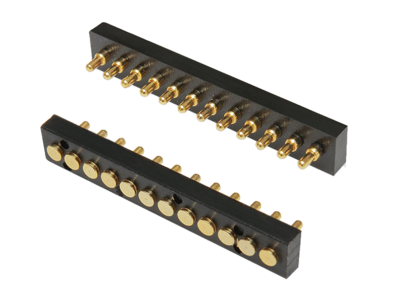Time:2025-03-18 Views:1 source:News

Flat - bottomed pogopins have emerged as a crucial component in modern electronic devices, offering unique advantages in electrical connection scenarios.
Structural Features
The defining characteristic of a flat - bottomed pogopin is its flat - shaped bottom end. This design is in contrast to the more traditional rounded or pointed pogopin tips. The flat bottom provides a larger contact surface area when making connections. It is typically made of high - conductivity materials such as beryllium c
oppe, which is then often plated with a thin layer of gold. The gold plating not only enhances the electrical conductivity but also improves corrosion resistance, ensuring reliable performance over time. The body of the flat - bottomed pogopin is designed to be flexible yet sturdy. It usually consists of a spring - loaded mechanism enclosed within a metal housing. The spring allows for a certain degree of compression and expansion, accommodating small variations in the distance between connection points.
Applications
In the consumer electronics industry, flat - bottomed pogopins find extensive use. For example, in smartphones, they are used to connect the printed circuit board (PCB) to various components such as the battery, camera module, and display. The large contact area of the flat - bottomed pogopin ensures a stable and low - resistance electrical connection, which is essential for efficient power transfer and signal transmission. In tablet devices, they are employed in the connection between the mainboard and expansion modules, like additional storage or wireless communication modules. This enables seamless integration of these modules without the need for complex soldering processes, facilitating easier device assembly and disassembly for maintenance or upgrades. In the automotive industry, flat - bottomed pogopins are used in the connection of in - car infotainment systems, sensors, and control units. Their ability to withstand vibrations and provide reliable connections in harsh environments makes them an ideal choice.
Performance Advantages
One of the key performance advantages of flat - bottomed pogopins is their enhanced current - carrying capacity. Due to the larger contact area, they can handle higher currents compared to some other types of pogopins. This is crucial in applications where significant power needs to be transferred, such as in high - performance computing devices. Additionally, the flat - bottom design reduces the risk of contact resistance variations. With a more uniform contact surface, the electrical resistance remains stable, minimizing power losses and ensuring consistent performance. The spring - loaded mechanism also provides self - alignment capabilities. When mating with a corresponding connector, the pogopin can adjust to small misalignments, ensuring a proper connection even in less - than - perfect assembly conditions.
Read recommendations:
Mass production of magnetic connectors
magnetic connector distributors